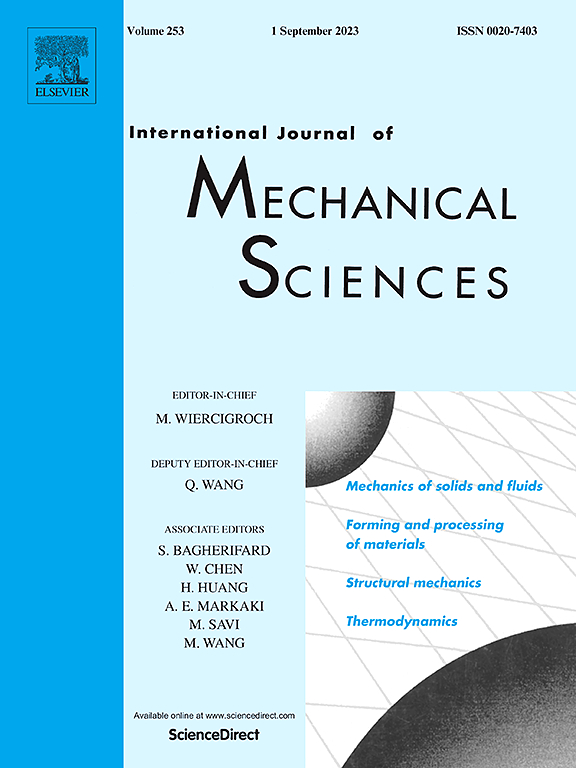Enhancing rejuvenation of metallic glass via vibration-superimposed elastic loads
IF 7.1
1区 工程技术
Q1 ENGINEERING, MECHANICAL
International Journal of Mechanical Sciences
Pub Date : 2025-04-17
DOI:10.1016/j.ijmecsci.2025.110285
引用次数: 0
Abstract
Structural rejuvenation significantly improves the plasticity of metallic glasses, though understanding its atomic mechanisms and identifying effective processing methods remain challenging. In this study, we investigate the effects of vibration-superimposed elastic loading on the structure and properties of metallic glasses through combined experiments and molecular dynamics simulations. The results demonstrate that superimposing vibration during elastic loading enhances structural rejuvenation and plasticity beyond what is achieved by elastic loading alone. Molecular dynamics simulations reveal that superimposed vibration increases atomic mobility and promotes local structural excitations (LSEs), which drive micro-plastic deformation entirely within the elastic regime. These LSEs facilitate the transformation of densely packed icosahedral (ICO)-like Voronoi polyhedron (VP) into mixed and crystal-like VPs, accompanied by an increase in excess free volume and structural disorder. Additionally, the redistribution of shear stress between ICO-like and non-ICO regions under superimposed vibration further promotes localized stress relaxation and plastic rearrangement. Overall, our findings demonstrate that vibration-superimposed elastic loading effectively induces atomic-level structural rejuvenation and enhances the plasticity of metallic glasses at room temperature, providing a promising strategy for improving their mechanical performance.

通过振动叠加弹性载荷增强金属玻璃的回春性
结构年轻化能显著改善金属玻璃的可塑性,但了解其原子机制和确定有效的加工方法仍具有挑战性。在本研究中,我们通过实验和分子动力学模拟,研究了振动叠加弹性加载对金属玻璃结构和性能的影响。结果表明,在弹性加载过程中叠加振动可增强结构再生和塑性,其效果超过了单纯的弹性加载。分子动力学模拟显示,叠加振动增加了原子的流动性,促进了局部结构激发(LSE),从而完全在弹性范围内驱动微塑性变形。这些局部结构激振促进了密集排列的二十面体(ICO)状伏罗诺伊多面体(VP)向混合晶体状伏罗诺多面体(VP)的转变,并伴随着过剩自由体积和结构紊乱的增加。此外,在叠加振动作用下,ICO 样区域和非 ICO 区域之间剪应力的重新分布进一步促进了局部应力松弛和塑性重排。总之,我们的研究结果表明,在室温下,振动叠加弹性加载能有效诱导原子级结构年轻化并增强金属玻璃的塑性,为改善其机械性能提供了一种前景广阔的策略。
本文章由计算机程序翻译,如有差异,请以英文原文为准。
求助全文
约1分钟内获得全文
求助全文
来源期刊

International Journal of Mechanical Sciences
工程技术-工程:机械
CiteScore
12.80
自引率
17.80%
发文量
769
审稿时长
19 days
期刊介绍:
The International Journal of Mechanical Sciences (IJMS) serves as a global platform for the publication and dissemination of original research that contributes to a deeper scientific understanding of the fundamental disciplines within mechanical, civil, and material engineering.
The primary focus of IJMS is to showcase innovative and ground-breaking work that utilizes analytical and computational modeling techniques, such as Finite Element Method (FEM), Boundary Element Method (BEM), and mesh-free methods, among others. These modeling methods are applied to diverse fields including rigid-body mechanics (e.g., dynamics, vibration, stability), structural mechanics, metal forming, advanced materials (e.g., metals, composites, cellular, smart) behavior and applications, impact mechanics, strain localization, and other nonlinear effects (e.g., large deflections, plasticity, fracture).
Additionally, IJMS covers the realms of fluid mechanics (both external and internal flows), tribology, thermodynamics, and materials processing. These subjects collectively form the core of the journal's content.
In summary, IJMS provides a prestigious platform for researchers to present their original contributions, shedding light on analytical and computational modeling methods in various areas of mechanical engineering, as well as exploring the behavior and application of advanced materials, fluid mechanics, thermodynamics, and materials processing.
 求助内容:
求助内容: 应助结果提醒方式:
应助结果提醒方式:


